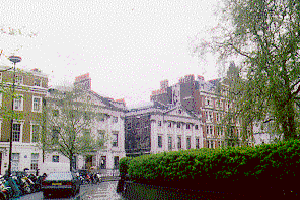The Harley estates in London

- Cavendish Square
- Cavendish Square, with Chandos House
[click on the picture to enlarge it]
Edward Harley, 2nd Earl of Oxford, son of Queen Anne’s Tory minister, developed his estates from 1717, north of the road leading from London to Oxford, which became known as ‘Oxford Street’ for these two coincidental reasons. Cavendish Square was named after his wife, Lady Henrietta Cavendish Holles; other streets were named after family titles and estates (Harley, Wigmore, Mortimer, de Vere in his family, Holles, Wimpole, Mansfield, Ogle, Welbeck, Clipstone, Carburton, Bolsover in his wife’s family; Henrietta and Margaret after his wife’s and daughter’s names). The architect John Wood worked at Cavendish Square before moving to Bath, where he built Queen Square on the same model.The North side of Cavendish Square is the town house of the Duke of Chandos, never completed, because of the financial crisis of the South Sea Bubble in 1720. The estate was largely inhabited by the Tories, and was meant as an answer to the Whig Hanover Square. Later in the century, the founder’s daughter and heiress Margaret married the Duke of Portland, grandson of the statesman who had been instrumental in bringing about the Glorious Revolution, and her estates were united with the neighbouring Portland estates.

